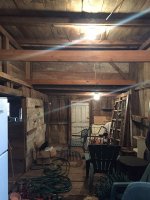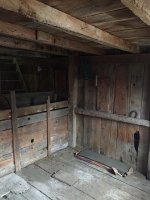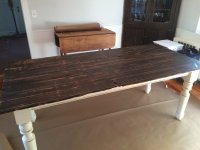maction17
Member
- Joined
- Mar 23, 2016
- Messages
- 19
What would you do? We bought the house that goes with the barn last spring, and I'm eager to get it set up as a proper workshop (as a hobbyist and DIYer), although I'm willing to take the long view on this. The barn was built around 1820, originally as a horse barn for the town doctor who would ride out to house calls from it. It's a solid structure, but not much of a foundation at all.
What it needs for sure:
A subpanel to run 220
A flat floor
Everything else I can peck away at.
[attachimg=1]
[attachimg=2]The left side had some work done before we came into possession. Some footings were installed and there's 3/4" ply on the floor. This was the previous owners stuff, but now this side is operating as my temporary workshop.
[attachimg=3]Leads up to an open loft (maybe a studio apt one day?)
[attachimg=4]The largest existing open space, on the left side of the barn. Stalls to the left could easily be removed to open it up more.
[attachimg=5]
View attachment 6 And here's a dining table that I made by repurposing some of the boards on the horse stall.
I'm open to any and all suggestions. I have a fella that specializes in lifting structures to install foundations, and I was thinking that might be the best place to start, but if there's a way to get a level floor without sinking that kind of money in, I'd love it. I wonder if I could just sand the hell out of everything with a Ro150...
What it needs for sure:
A subpanel to run 220
A flat floor
Everything else I can peck away at.
[attachimg=1]
[attachimg=2]The left side had some work done before we came into possession. Some footings were installed and there's 3/4" ply on the floor. This was the previous owners stuff, but now this side is operating as my temporary workshop.
[attachimg=3]Leads up to an open loft (maybe a studio apt one day?)
[attachimg=4]The largest existing open space, on the left side of the barn. Stalls to the left could easily be removed to open it up more.
[attachimg=5]
View attachment 6 And here's a dining table that I made by repurposing some of the boards on the horse stall.
I'm open to any and all suggestions. I have a fella that specializes in lifting structures to install foundations, and I was thinking that might be the best place to start, but if there's a way to get a level floor without sinking that kind of money in, I'd love it. I wonder if I could just sand the hell out of everything with a Ro150...
Attachments
-
 17122178061_ef13004b40_z (1).jpg123.9 KB · Views: 1,944
17122178061_ef13004b40_z (1).jpg123.9 KB · Views: 1,944 -
 16502669023_32a7449294_z.jpg103 KB · Views: 1,971
16502669023_32a7449294_z.jpg103 KB · Views: 1,971 -
 16935277940_fef377e197_z.jpg123.9 KB · Views: 1,843
16935277940_fef377e197_z.jpg123.9 KB · Views: 1,843 -
 17096878336_3d625fc7e6_z.jpg112.8 KB · Views: 1,898
17096878336_3d625fc7e6_z.jpg112.8 KB · Views: 1,898 -
 17122818215_c7ab8bbc8a_z.jpg109.4 KB · Views: 1,888
17122818215_c7ab8bbc8a_z.jpg109.4 KB · Views: 1,888 -
 718A5554-7629-482A-9B9F-00A46AC036B7.JPG1.4 MB · Views: 371
718A5554-7629-482A-9B9F-00A46AC036B7.JPG1.4 MB · Views: 371
